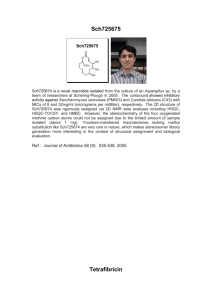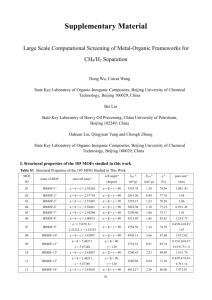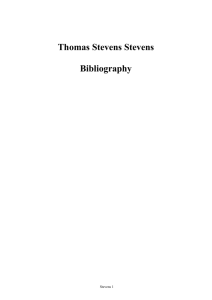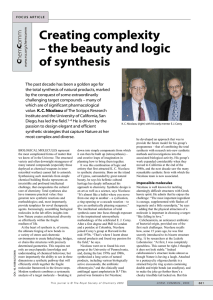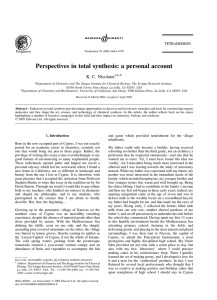Notes on CH402 MW component:
advertisement
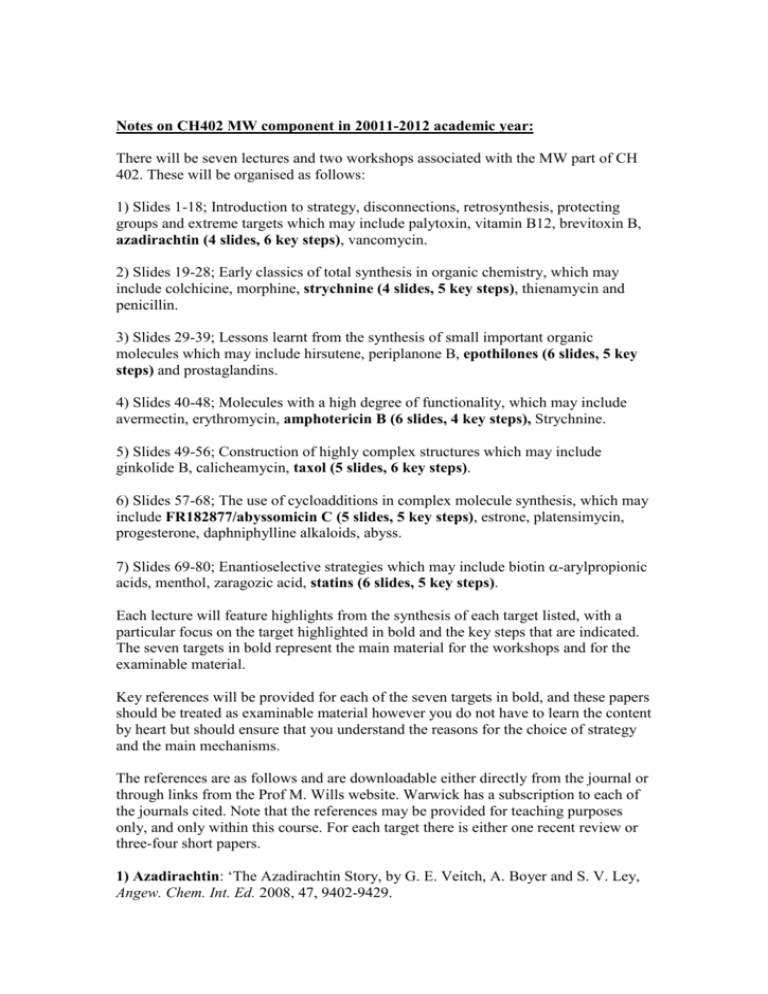
Notes on CH402 MW component in 20011-2012 academic year: There will be seven lectures and two workshops associated with the MW part of CH 402. These will be organised as follows: 1) Slides 1-18; Introduction to strategy, disconnections, retrosynthesis, protecting groups and extreme targets which may include palytoxin, vitamin B12, brevitoxin B, azadirachtin (4 slides, 6 key steps), vancomycin. 2) Slides 19-28; Early classics of total synthesis in organic chemistry, which may include colchicine, morphine, strychnine (4 slides, 5 key steps), thienamycin and penicillin. 3) Slides 29-39; Lessons learnt from the synthesis of small important organic molecules which may include hirsutene, periplanone B, epothilones (6 slides, 5 key steps) and prostaglandins. 4) Slides 40-48; Molecules with a high degree of functionality, which may include avermectin, erythromycin, amphotericin B (6 slides, 4 key steps), Strychnine. 5) Slides 49-56; Construction of highly complex structures which may include ginkolide B, calicheamycin, taxol (5 slides, 6 key steps). 6) Slides 57-68; The use of cycloadditions in complex molecule synthesis, which may include FR182877/abyssomicin C (5 slides, 5 key steps), estrone, platensimycin, progesterone, daphniphylline alkaloids, abyss. 7) Slides 69-80; Enantioselective strategies which may include biotin -arylpropionic acids, menthol, zaragozic acid, statins (6 slides, 5 key steps). Each lecture will feature highlights from the synthesis of each target listed, with a particular focus on the target highlighted in bold and the key steps that are indicated. The seven targets in bold represent the main material for the workshops and for the examinable material. Key references will be provided for each of the seven targets in bold, and these papers should be treated as examinable material however you do not have to learn the content by heart but should ensure that you understand the reasons for the choice of strategy and the main mechanisms. The references are as follows and are downloadable either directly from the journal or through links from the Prof M. Wills website. Warwick has a subscription to each of the journals cited. Note that the references may be provided for teaching purposes only, and only within this course. For each target there is either one recent review or three-four short papers. 1) Azadirachtin: ‘The Azadirachtin Story, by G. E. Veitch, A. Boyer and S. V. Ley, Angew. Chem. Int. Ed. 2008, 47, 9402-9429. 2) Strychnine. a) A synthesis of strychnine by a longest linear sequence of six steps’ D. B. C. Martin and C. D. Vanderwal, Chemical Science, 2011, 2, 649-651. b) S. D. Knight, L. E. Overman and G. Pairaudeau, J. Am. Chem. Soc. 1993, 115, 9293–9294. c) T. Ohshira, Y. Xu, R. Takita, S. Shimizu, D. Zhong and M. Shibasaki, J. Am. Chem. Soc, 2002, 124, 14546-14547. d) G. Sirasani, T. Paul, W. Dougherty Jr., S. Kassel and R. B Andrade, J. Org. Chem. 2010, 75, 3529-3532. 3) Epothilones; ‘Epothilones – a fascinating family of microtubule stabilizing antitumor agents’, J. Mulzer, K.-H. Altmann, G. Höfle, R. Müller and K. Prantz, C. R. Chemie 2008, 11, 1336. 4) Amphotericin B. a) Synthesis of 35-deoxy amphotericin B methyl ester: a strategy for molecular editing;, A. M. Szpilman, D. M. Cereghette, N. R. Wurtz, J. M. Manthorpe and E. M. Carreira, Angew. Chem. Int. Ed. 2008, 47, 4335-4338. b) Total synthesis of (+)-roxacitin via C-C bond forming transfer hydrogenation...’ S. B. Han, A. Hassan, I. S. Kim and M. J. Krische, J. Am. Chem. Soc. 2010, 132, 15559-15561. c) K. C. Nicolaou, R. A. Daines, J. Uenishi, W. S. Li, D. P. Paphatjis and T. K. Chakraborty, J. Am. Chem. Soc. 1988, 110, 4672-4685. . 5) Taxol; a) ‘The Conquest of Taxol’, K. C. Nicolaou and R. K. Guy, Angew. Chem. Int. Ed. 1995, 34, 2079-2090. b) R. A. Holton, H.-B. Kim, C. Somoza, F. Liang, R. J. Biediger, P.D. Boatman, M. Shindo, C. C. Smith, S. Kim, H. Nadizadeh, Y. Suzuki, C. Tao, P. Vu, S. Tang, P. Zhang, K. K. Murthi, L. N. Gentle and J. W. Liu, J. Am. Chem. Soc. 1994, 116, 1599-1600. c) P. Bremond, G. Audran and H. Monti, J. Org. Chem. 2008, 73, 6033-6036. 6) FR182877. a) D. A. Vosberg, C. D. Vandewall and E. J. Sorensen, . J. Am. Chem. Soc. 2002, 124, 4552-4553. b) D. A. Evans and J. T. Starr, Angew. Chem. Int. Ed.. 2002, 41,1787-1790. c) C. W. Zapf, B. A. Harrison, C. Drahl and S. J. Sorenson, Angew. Chem. Int. Ed.. 2005, 44,6533-6537. d) K. C. Nicolaou and S. T. Harrison. J. Am. Chem. Soc. 2007, 129, 429-440. 7) Statins. a) M. Hirama and M. Uei, J. Am. Chem. Soc. 1982, 104, 4251-4253. b) T. Sammakia, D. J. Johns, G. Kim and M. A. Berliner, J. Am. Chem. Soc. 2005, 127, 6504-6505. c) J. Robichaud and F. Tremblay, Org. Lett. 2006, 8, 597-600. Exam structure. The exam will test your understanding of the synthetic strategies towards the seven targets in each section of the course, why they were selected and why particular routes were chosen. You will be told which steps to focus revision on.







